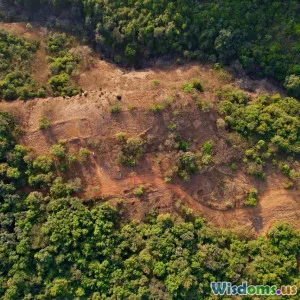
Are Carbon Offsets Effective or Just Greenwashing
7 min read Explore if carbon offsets truly reduce emissions or serve as greenwashing, with data, expert insights, and real-world examples. (0 Reviews)
Are Carbon Offsets Effective or Just Greenwashing?
Introduction
In the race to combat climate change, carbon offsets have emerged as a popular solution promising to neutralize greenhouse gas emissions by investing in environmental projects. From companies pledging “carbon neutrality” to individuals offsetting travel footprints, the concept sounds hopeful and simple. But underneath the green veneer lies a contentious debate: Are carbon offsets an effective tool in reducing actual emissions, or are they merely a form of corporate greenwashing that masks harmful practices?
This article explores the mechanics of carbon offsets, evaluates their effectiveness through evidence and expert insights, and ultimately asks whether offsets can truly support sustainability or if they perpetuate environmental complacency. Understanding this distinction is crucial for anyone looking to make informed decisions about climate action.
What Are Carbon Offsets?
Carbon offsets represent quantifiable reductions in greenhouse gas emissions, purchased to counterbalance emissions occurring elsewhere. For example, a corporation emits one metric ton of CO2 from factory operations but funds reforestation initiatives that sequester an equivalent amount. This theoretically renders the net carbon footprint zero.
Types of Carbon Offset Projects
- Reforestation & Afforestation: Planting trees to absorb CO2.
- Renewable Energy Projects: Financing wind, solar, or hydro-power plants to displace fossil fuels.
- Methane Capture: Projects at landfills or farms capturing potent methane gas.
- Energy Efficiency Initiatives: Improvements in manufacturing or building efficiencies.
Organizations like Verified Carbon Standard (VCS) and Gold Standard certify such projects to ensure credibility.
Effectiveness of Carbon Offsets: The Evidence
While the idea of compensating emissions through offset credits is conceptually compelling, the real-world efficacy of offsets is mixed.
Measuring Real Impact: Additionality & Permanence
Two core principles govern valid offsets:
- Additionality: The project would not have occurred without the offset funding.
- Permanence: The carbon reduction or sequestration must last long enough to have climate benefit.
Unfortunately, many offset projects struggle with these.
Example: A 2019 study published in Science highlighted that many forest-based offsets failed to demonstrate clear additionality; some tree-planting projects were simply accounting for what was already planned.
Similarly, permanence is challenged by risks like forest fires, disease, or logging, which can release sequestered carbon back into the atmosphere decades later.
Leakage and Double Counting
Leakage occurs if reducing emissions in one area causes displacement of emissions elsewhere, negating overall gains. For example, protecting one forest might push logging activities to another region.
Double counting, where multiple actors claim credit for the same carbon reduction, exacerbates inaccuracies. Despite verification bodies, robust tracking remains complex.
Criticisms and Greenwashing Concerns
Carbon offsets have drawn criticism for enabling a “pay-to-pollute” culture. Critics argue they allow companies to avoid addressing systemic changes by purchasing mitigations instead of reducing actual emissions.
Greenpeace’s climate campaigner, Jorg Steffens, stated: “Offsets are a dangerous distraction, allowing big polluters to keep business as usual.”
Similarly, investigations have uncovered cases where offset projects provide minimal benefits or are outright fraudulent.
Positive Examples and Success Stories
Amid criticism, some offset programs deliver tangible environmental and social outcomes, proving offsets can contribute when implemented rigorously.
Examples
- Cool Earth: Projects in the Amazon rainforest not only prevent deforestation but empower indigenous communities, blending climate action with social justice.
- Kenya’s Clean Cooking Project: Reduced biomass use and emissions, improving health and reducing deforestation.
These examples embrace co-benefits like biodiversity protection and community development, which pure carbon accounting often overlooks.
The Role of Carbon Offsets in Corporate Sustainability
Many Fortune 500 companies include offsets as part of their climate strategies. Microsoft, for instance, has committed to becoming carbon negative by 2030 by heavily investing in offsets alongside emissions reductions.
Yet, sustainability experts urge caution.
Dr. Michael Gillenwater, a carbon markets analyst, notes: “Offsets should be a last resort after all feasible emission reductions have been made. Viewed as a supplement, not a substitute.”
Emerging Innovations and Improvements
To address pitfalls, innovations are evolving:
- Blockchain and Satellite Monitoring: Enhance transparency and reduce double counting.
- Nature-Based Solutions Certification: More stringent standards to ensure additionality and permanence.
- Integration with Net-Zero Targets: Aligning offsets with verified emissions reductions in broader frameworks.
Furthermore, more organizations are coupling offsets with aggressive internal carbon reduction plans.
Conclusion: A Tool, Not a Panacea
Carbon offsets are neither a simple fix nor inherently deceptive. When carefully designed and transparently implemented, offset projects can contribute meaningfully to climate mitigation — especially when they deliver co-benefits such as biodiversity preservation and community empowerment.
However, relying solely on offsets, particularly cheap or poorly vetted credits, risks undermining climate goals and fuels accusations of greenwashing.
The future of carbon offsets lies in better verification, robust regulation, increasing accountability, and explicit honesty about their limitations.
For citizens, businesses, and policymakers, the takeaway is clear: prioritize direct emissions reductions first. Use carbon offsets as a complementary measure—not a substitute—and advocate for systems that ensure that every dollar spent genuinely moves us closer to a sustainable planet.
Understanding carbon offsets beyond buzzwords is essential to supporting effective climate action rather than falling prey to greenwashed illusions.
References:
- Ramanathan, V., et al. (2019). Evaluating the impact of forest carbon offsets. Science, 365(6454).
- Greenpeace International. (2021). The deceptive nature of carbon offsetting.
- Microsoft Sustainability Report 2023.
- Cool Earth Impact Reports.
Engage, question, and act—because our climate future depends on informed choices.
Rate the Post
User Reviews
Popular Posts





















